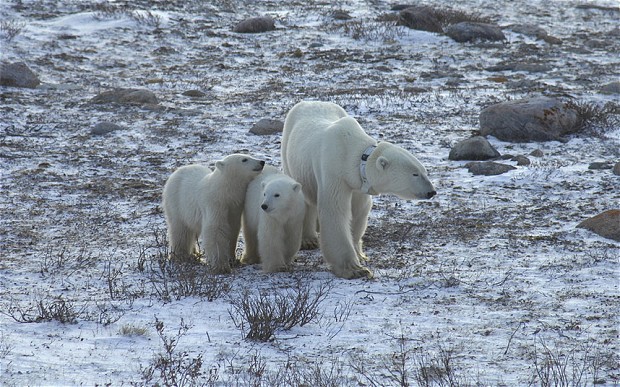'Fattest' polar bears survive climate change
The latest study into the effects of climate change on polar bears has found only the ‘fattest’ survive the shrinking of the ice.

An adult female polar bear wearing a GPS-satellite linked collar with her two 10-month-old cubs waits for the sea ice to re-form onshore in western Hudson Bay, Manitoba, Canada
The polar bears of Hudson Bay, Canada migrate onto land in the summer when the sea ice melts, relying on fat reserves to survive until the sea re-freezes in late November or early December.
During the winter and spring months they use the sea ice to hunt their prey of seals.
But the bears were coming to land earlier and leaving later in recent years as a result of climate change which was reducing the ice, researchers writing in the Journal of Animal Ecology from the British Ecological Society said.
The longer the bears spend on land, the longer they have to go without their energy-rich seal food with consequent impacts on their health and survival
Longer stretches without food were hitting the predators’ health, breeding success and population as for polar bears, “it’s survival of the fattest”, the researchers said.
The research involved monitoring 109 female polar bears between 1991 and 1997 and between 2004 and 2009, using radio collars, which cannot be fitted to male bears as their necks are wider than their heads and the devices would fall off.
The team, led by Dr Seth Cherry, of the University of Alberta, Canada, also monitored the position and concentration of sea ice using satellite images.
The migration patterns of the polar bears were governed by the conditions of the sea ice, and climate-induced changes to the rate and timing of sea ice melt and re-freezing affected how long the bears spend on land, the study said.
Tracking the bears revealed a trend of them arriving onshore earlier in the spring and departing later in the autumn.
Previous studies have shown that the western Hudson Bay polar bear population, recently estimated at around 900 animals, has declined since the 1990s, as have their body condition and the number of cubs surviving to adulthood.
Dr Cherry said: “The data suggest that in recent years, polar bears are arriving on shore earlier in the summer and leaving later in the autumn.
“These are precisely the kind of changes one would expect to see as a result of a warming climate and may help explain some other studies that are showing declines in body condition and cub production.”
The longer the bears spend on land, the longer they have to go without their energy-rich seal food with consequent impacts on their health and survival.
“Climate-induced changes that cause sea ice to melt earlier, form later, or both, likely affect the overall health of polar bears in the area.
“Ultimately, for polar bears, it’s survival of the fattest,” he added.

An adult female polar bear wearing a GPS-satellite linked collar with her two 10-month-old cubs waits for the sea ice to re-form onshore in western Hudson Bay, Manitoba, Canada
The polar bears of Hudson Bay, Canada migrate onto land in the summer when the sea ice melts, relying on fat reserves to survive until the sea re-freezes in late November or early December.
During the winter and spring months they use the sea ice to hunt their prey of seals.
But the bears were coming to land earlier and leaving later in recent years as a result of climate change which was reducing the ice, researchers writing in the Journal of Animal Ecology from the British Ecological Society said.
The longer the bears spend on land, the longer they have to go without their energy-rich seal food with consequent impacts on their health and survival
Longer stretches without food were hitting the predators’ health, breeding success and population as for polar bears, “it’s survival of the fattest”, the researchers said.
The research involved monitoring 109 female polar bears between 1991 and 1997 and between 2004 and 2009, using radio collars, which cannot be fitted to male bears as their necks are wider than their heads and the devices would fall off.
The team, led by Dr Seth Cherry, of the University of Alberta, Canada, also monitored the position and concentration of sea ice using satellite images.
The migration patterns of the polar bears were governed by the conditions of the sea ice, and climate-induced changes to the rate and timing of sea ice melt and re-freezing affected how long the bears spend on land, the study said.
Tracking the bears revealed a trend of them arriving onshore earlier in the spring and departing later in the autumn.
Previous studies have shown that the western Hudson Bay polar bear population, recently estimated at around 900 animals, has declined since the 1990s, as have their body condition and the number of cubs surviving to adulthood.
Dr Cherry said: “The data suggest that in recent years, polar bears are arriving on shore earlier in the summer and leaving later in the autumn.
“These are precisely the kind of changes one would expect to see as a result of a warming climate and may help explain some other studies that are showing declines in body condition and cub production.”
The longer the bears spend on land, the longer they have to go without their energy-rich seal food with consequent impacts on their health and survival.
“Climate-induced changes that cause sea ice to melt earlier, form later, or both, likely affect the overall health of polar bears in the area.
“Ultimately, for polar bears, it’s survival of the fattest,” he added.
You can return to the main Market News page, or press the Back button on your browser.

